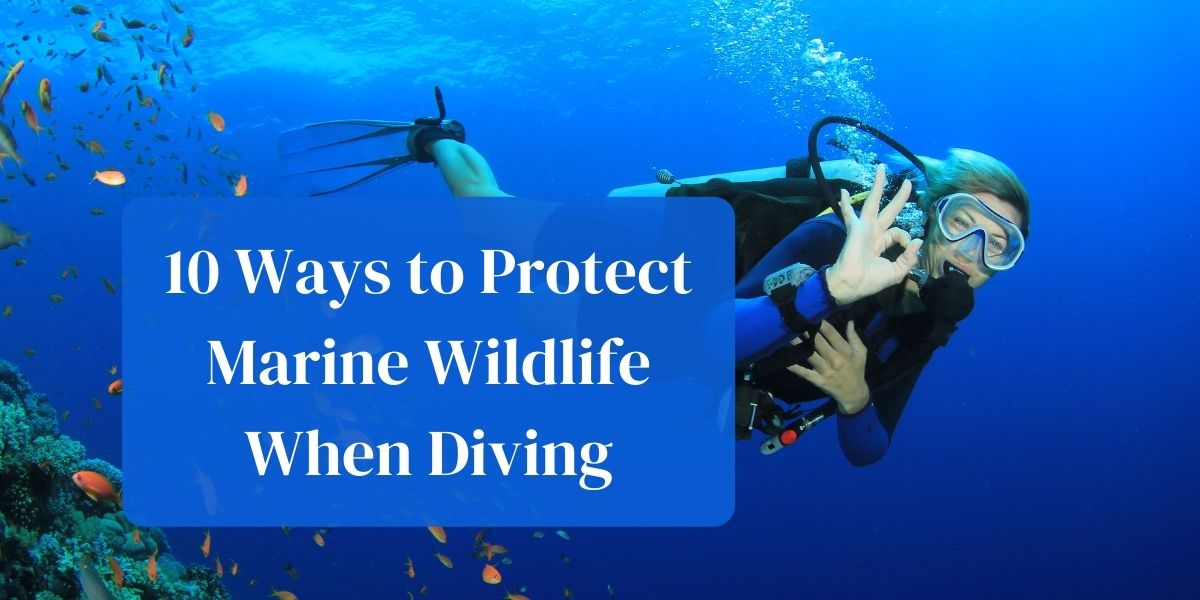Tips for choosing a responsible dive operator and exploring the undersea world responsibly to protect marine wildlife.
Being a visitor in the underwater environment is undoubtedly one of the most stunning travel experiences available. But, in order to avoid accidently harming the fauna, what should you be aware of when exploring reefs? And how can you tell whether a dive operator is concerned about marine life? Here are some guidelines to help you dive more responsibly:
Table of Contents
- 1. Take a look, but don’t touch!
- 2. Keep Animal Disturbances to a Minimum
- 3. Taking Care of the Fish
- 4. Maintain control
- 5. Be Aware of Your Tools
- 6. Don’t Anchor in Tight Spots
- 7. Animals Aren’t For Sale As Souvenirs
- 8. Use a sunscreen that is reef-safe
- 9. Keep an eye out for environmentally friendly business practices
- 10. Educate Yourself to protect marine wildlife when diving
1. Take a look, but don’t touch!
Don’t touch, hold, or ride any of the animals you come across. Have you ever wondered why fish are so slick? Fish and other marine creatures have a slimy mucous covering that protects them from illnesses and can also serve as a deterrent to predators. This covering is destroyed when you touch them. Be wary of dive operators who pick up animals for a close-up view to dazzle tourists. Tourists will be reminded not to touch marine life, gloves will be discouraged, and access and departure points over shallow coral will be avoided. Check out the diving operator’s website before making a reservation. If you see photographs of divers riding sea turtles or clutching sea stars, you should probably avoid doing business with them.
2. Keep Animal Disturbances to a Minimum
Getting too near to or pursuing marine animals might stress them out and force them to change their normal behaviour. When one animal begins to act erratically, it might throw the ecosystem’s equilibrium off. This is something that guides should mention during their briefing. Keep in mind that the fewer divers in a given location, the less animal disturbance there will be. Ask how many divers they generally take out in a group when considering dive operators – the fewer the group, the better.
3. Taking Care of the Fish
It may be tempting to bring food with you to entice swarms of fish (many guides are guilty of this), but feeding them can actually hurt them. When fish eat from humans, they stop fulfilling their natural functions, such as removing algae off coral reefs. They may also get irritable or ill. Before you schedule your trip, inquire about the feeding policies of the diving operator.
4. Maintain control
The most crucial skills that divers should acquire to avoid slamming into the reef are neutral buoyancy and precise body posture, or trim. When a diver tears off a little piece of coral, it might take years to restore the damage. Dive operators should verify that their guests are familiar with the methods before traveling to the reef. This involves giving new or inexperienced divers in-water buoyancy instruction. To avoid inexperienced divers from winding up in difficult-to-manage regions like caverns or wrecks, dive guides should match diver skill levels to dive destinations.
5. Be Aware of Your Tools
Make sure you know how big you are with your fins and tank on before you find yourself surrounded by delicate corals. Simply moving up the silt can hurt the coral by obstructing its access to the light it requires to thrive. Make sure that your gauge and regulator are securely tucked in so that they don’t end up dragging across the coral. Because buoyancy differs while holding a big camera underwater, underwater photographers must take particular caution. In-water training should be included in beginner diver orientation to help new divers become familiar with their equipment while swimming.
6. Don’t Anchor in Tight Spots
Divers should never anchor or beach their boat near fragile or vulnerable regions like coral reefs, turtle nesting beaches, bird nesting places, or seagrass beds. Anchors may inflict significant damage, especially if the chain is dragged back and forth across an entire portion of the reef by the wind or current. When possible, tying up to mooring buoys or drift diving are responsible options.
7. Animals Aren’t For Sale As Souvenirs
Marine species should not be gathered from the water or sold as souvenirs, whether living or dead. By removing specific creatures, other animals are deprived of a food supply, and an invading species may thrive. For creatures that rely on the decomposition process or refuge, even dead organisms serve a significant service. Purchasing these products merely adds to the demand for them and encourages them to be harvested in the future. Avoid diving businesses that sell or exhibit marine wildlife-related items.
8. Use a sunscreen that is reef-safe
Many ingredients in regular sunscreens are hazardous to marine life or can induce coral bleaching. When going into the ocean, it’s a good idea to wear an environmentally friendly alternative or sun-protective apparel. Keep in mind that just because a product claims to be “reef safe” doesn’t imply it is. Do your homework and read the labels for any potentially dangerous components. Divers must now wear reef-safe sunscreen in some marine protected areas and dive operators; nonetheless, the option to be educated and act ethically is ultimately yours.
9. Keep an eye out for environmentally friendly business practices
Look for diving shops that make sustainability a part of their day-to-day operations. Do they adopt any energy or water conservation measures? How do they get rid of trash? Are they involved in any reef cleanups, conservation initiatives, or environmental education programs in their community? Look for operators that have received eco-certifications or follow the Green Fins environmental requirements for diving and snorkeling. However, just because an operator isn’t qualified doesn’t imply they’re not a good choice for the environment. Look through their website to see whether they mention sustainability, and if you can’t find anything there, ask!
10. Educate Yourself to protect marine wildlife when diving
Knowing what you’re seeing while diving will enhance your experience and allow you to better comprehend your effect. Before you go, do some research on the local marine ecology — there are many of books and online resources available. Alternatively, simply ask your tour guide. In their briefing, a professional dive operator would provide information about the local ecosystem and conservation. Many will also provide you with reef identification cards and teach you how to use hand gestures to point out certain animals under water. If they’re serious about marine animal conservation, they should be able to alert you to any sensitive settings or endangered species to be aware of. The more information you have, the easier it will be for you to make smart diving decisions!
If you want to learn more about marine life, visit Ocean First Education, which offers online marine science courses.
For more information about sustainable travel practices, be sure to check out our other blog posts here.








